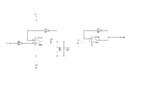ste2006
Advanced Member level 4
Hi,
I have designed and am using a peak detector for a 50Hz AC Signal coming from a Current Transformer and ultimately into a microcontroller ADC, Problem is i did the circuit up on bread board with a TH LM324N and the circuit worked perfectly,
Now i have gone and got a PCB made up using a SOIC LM324DG4 and while the peak detector works up to about 0.6V once the input goes above this the output just saturates to 5V
I have a schematic below but it is rather simple

The two OP-Amps i purchased in RS in case anyone can see a difference,
TH one that works 268-0002
SOIC that saturates 661-0521
I ultimately need it to work to about 4V P-P
Anyone any ideas it would be great as this is really puzzling me,
Thanks,
I have designed and am using a peak detector for a 50Hz AC Signal coming from a Current Transformer and ultimately into a microcontroller ADC, Problem is i did the circuit up on bread board with a TH LM324N and the circuit worked perfectly,
Now i have gone and got a PCB made up using a SOIC LM324DG4 and while the peak detector works up to about 0.6V once the input goes above this the output just saturates to 5V
I have a schematic below but it is rather simple

The two OP-Amps i purchased in RS in case anyone can see a difference,
TH one that works 268-0002
SOIC that saturates 661-0521
I ultimately need it to work to about 4V P-P
Anyone any ideas it would be great as this is really puzzling me,
Thanks,
